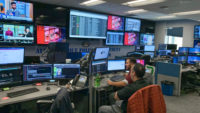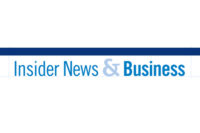HealthEast Care System is among the largest privately owned healthcare providers in Minnesota. Located in the Twin Cities’ east metro area, HealthEast operates three acute care facilities and one long-term care facility as well as a variety of outpatient services, 14 primary and specialty care clinics, home care, and medical transportation services.
The organization prides itself on providing high-quality, compassionate, cost-effective health care to the community it serves. Ensuring the safety and security of every patient, visitor, volunteer and staff member is an important aspect of HealthEast’s daily operations.
HealthEast facilities accommodate 7,300 employees, 1,200 volunteers and 1,500 physicians, in addition to a continuous flow of patients and visitors.
Until recently, security and safety operations for the care system were handled at security booths located at five different facilities. Operators at each station would answer phones, help visitors, monitor surveillance and respond to alarms. However, because none of these stations were staffed 24/7, response times were often delayed.
Several months ago, in an effort to improve efficiency and reduce costs, HealthEast consolidated its security and safety operations into a single operations center, which is designed to manage the entire HealthEast security system and is staffed around the clock.
Mark Johnson, director of safety and security services for HealthEast, was responsible for the consolidation and knew that a major feature of the new operations center needed to be a control console that would enable operators to easily monitor multiple systems at once.
In order to find the right solution, Johnson met with several different console manufacturers to get an idea about what was available.
One of the challenges he faced when choosing a console was that the space for the operations center, from the layout of the walls to the ceiling height, was predefined and relatively small. Whatever console solution he chose would have to be scaled to the room.
“I didn’t find a whole lot of products that I could scale for that size room and still have a big layout with enough space for all of our monitors,” said Johnson. “And because it would be a 24/7/365 operation center, the console would need to be both durable and ergonomically sound for a variety of operators.”
Ultimately, Johnson chose a Winsted EnVision console because it met HealthEast’s requirements for scalability, ergonomics and durability.
Available in single, double or triple tier configurations, EnVision consoles are designed to offer a balance of form and function. Each tier supports a 7 1/2-inch or 15-inch high Slat-Wall section with multiple monitor mounting positions for optimal sightlines and ergonomically correct viewing angles.
Johnson worked with Winsted to design a console that would make it possible to scale a variety of different monitor sizes in an ergonomic, form-fitting function that could be manned by one, two or three dispatchers at a time.
“We had to have a really good workflow that went along with the layout,” said Johnson. “And the layout was probably one of the more challenging pieces that any manufacturer had with us because we had a pre-designated size in width, length and height.”
After several rounds of revisions, they settled on a J-shaped console. Johnson said this shape makes it possible for one dispatcher to sit at the console and view every monitor in the room, or for two or three dispatchers to sit at the console with the same functionality.
In total, 26 monitors are mounted to the console using Winsted’s flexible Slat-Wall monitor mounting system. Most of the monitors are 24-inch LEDs, but the layout also includes a 55-inch monitor, two 42-inch monitors and two 24-inch touchscreen monitors.
The touchscreen monitors added another important consideration for the overall console design. In order for dispatchers to easily reach out and touch those screens, the console’s work surface needed to be 22 3/4 inches deep. Because Winsted’s work surfaces are custom to each console, they were able to easily accommodate this need.
Because of the 24/7 nature of the operations center, HealthEast needed a work surface that could withstand years of constant use. Aesthetically, they also needed to work within a very specific range of corporate design colors. They chose a laminated Comfort Edge™ work surface because of its durability and the array of color options available.
“It’s so hard to determine actual colors of products like work surfaces from printed chips,” said Johnson. “Winsted actually provided us with larger color samples of the actual work surface as well as the bumper edge, so we could look at and touch the samples. Everything was very tactile. That really made it much easier for us to make the best decision.”
Johnson went on to explain that the entire design process with Winsted was very helpful. “They provided us with an initial CAD drawing, tweaked it a little bit based on our revisions, then came back with a 3D CAD drawing, tweaked it a bit again and finally came back with full-color 3D drawings from several views so we knew exactly what we were getting,” he said. “There were no surprises.”
The new operations center has provided the entire HealthEast Care System with a security and safety operation that can be controlled from a single location, providing greater efficiency and continuity of services.
“In just the first six months after the security operations center opened, the dispatchers have logged an average of 13,000 calls for service each month, monitored more than 800 cameras, and received tens of thousands of phone calls,” said Johnson. “The monitoring system layout as well maximizes viewing capability, so dispatchers have also served as a front line of defense. They’ve been able to identify criminal activity, safety issues and people needing assistance, and then assign appropriate staff to take care of the matter at hand.”
With the new security operations center in full operation, HealthEast’s dispatchers help ensure the safety and security of every patient, visitor, volunteer and staff member that goes in and out of the facility on a 24/7 basis.
“We have a better, more fluid, more efficient operations center by having something that was designed to do this versus something that was just put together piecemeal over time,” said Johnson. “Access control, surveillance, alarms, calls for escorts, and communication with onsite security personnel can all be monitored and controlled from one centralized location now.”










